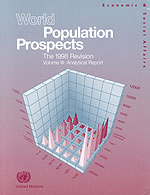 |
World Population Prospects.
The 1998 Revision. Volume III : Analytical Report.
NY, UN, 2000 247 pages
|
Третий том демографических прогнозов
ООН пересмотра 1998 года содержит подробный анализ прогнозируемых
изменений демографических процессов и роста населения в мире в целом
и в 184 странах за период до 2050 года.
Содержание тома
Preface
Explanatory notes
Introduction
A. The key results of the 1998 Revision
B. A comparison of the 1996 Revision and the 1998 Revision
C. Organization of the rest of the report
Chapter
I. The transition to low fertility and its implications for
the future
A. Comparing the fertility transition in different groups of
countries
B. The future of the fertility transition
C. The fertility transition at the regional level
D. The fertility contribution to population growth
E. Age patterns of fertility
II. Past and future trends in mortality
A. The mortality transition in the second part of the twentieth
century
B. Future prospects for the transition to low mortality
C. The number of death
D. Mortality in childhood
III. The demographic impact of AIDS
A. Estimating and projecting the impact of HIV/AIDS
B. Characteristics of the HIV epidemic
C. The impact of AIDS
D. Conclusion
IV. International migration
V. Population size and composition
A. The growth of the world population
B. Population dynamics in the major areas of the world
C. Population growth at the regional level
D. The dynamics of population growth at the country level
E. The changing age distribution of the world population
F. Population ageing at the regional level
G. The implications of ageing populations
H. The oldest old
VI. Methodology of the United Nations population estimates and
projections
A. The revision of past estimates of population dynamics
B. The assumptions made in projecting fertility
C. The assumptions made in projecting mortality
D. The projection of international migration
VII. Sources of data and demographic methods
Annex
|

